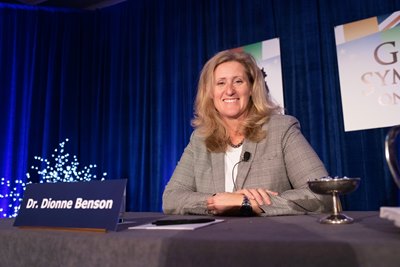Equine Safety Reform Discussed at Arizona Symposium


Before an audience of racing executives and leaders, three speakers called for comprehensive reform and industry cooperation during a morning panel on Racing's Safety and Welfare Initiatives Dec. 10 at the University of Arizona's Global Symposium on Racing in Tucson, Ariz.
Dr. Dionne Benson, chief veterinary officer for The Stronach Group, discussed initiatives that major tracks in California have undertaken since March after Santa Anita Park experienced a rash in breakdowns. Among these were dramatic changes in medication policy, as well as increased veterinary monitoring.
Benson emphasized this is not simply a problem for California, where TSG owns Santa Anita and Golden Gate Fields. She displayed a slide of news headlines from horse deaths, all from tracks outside California, from Kentucky to Hong Kong.
"This can happen at your track. The time to act is now," she said.
Benson reported a sharp reduction in injuries at Santa Anita since TSG and the California Horse Racing Board began widespread equine safety initiatives there in late March. Among these was a 14-day stand down on intra-articular medications and the elimination of stacking; a 48-hour such period for non-steroidal anti-inflammatory drugs; and a required private veterinarian exam within three days of entry.
Additionally, as authorized by the California Horse Racing Board, participating horses have since June been required to clear a "Governor's Review Panel," a five-member group that looks for "at risk" horses, scratching some and calling for the further examinations of others.
TSG has also extended its oversight to workouts, implementing many of the same protocols from racing, with the goal of reducing medication to reduce the chance of an injury going undetected. Private veterinarians are also required to inspect these runners, whom must be registered 48 hours prior to recording workouts.
These steps, along with increased veterinary presence, have resulted in a safer statistics, Benson said. Presenting slides to the audience, she said musculoskeletal fatalities during racing declined from 4.06 per 1,000 starts from December through March to 1.23 for the remainder of the winter/spring meet. That number was 2.68 during Santa Anita's fall meet, according to her presentation.
Reductions also occurred during training, dropping from a musculoskeletal-fatality rate of .91 per 1,000 starts during December through March to .32 over the end of the winter/spring meet and to .21 during the fall, per her statistics.
"This can work. Preventions can happen," she said.
She said TSG will spend approximately $3 million in new veterinary equipment. A revolutionary Positron Emission Tomography scanner, what she hopes can be a "game changer" for diagnosing sesamoid injuries, is expected to be delivered to Santa Anita this week, she said.
Later, after a question from the audience, Benson defended TSG pushing for the eventual elimination of the use of Lasix, a medication used to control respiratory bleeding. Though she said there is no proven causational relationship linked it to breakdowns, she views it as having the potential to be performance enhancing by expediting weight loss. Horses in California can now receive 5cc of Lasix, a 50% reduction from the prior threshold.

Colonial Downs, which conducted a 15-day meet this past summer, reported favorable returns during its short season. The track did not have a single fatality from racing or training, according to Jill Byrne, vice president of racing operations. It ran 144 races.
Reopened this year after being closed since 2013, the track began with a "blank slate" and with the luxury of being proactive, Byrne said. This meant revamping its turf and dirt courses. The turf course required a controlled burn to remove old grass, reseeding, and a phase-in of a new irrigation system.
With the support of the racing commission in Virginia, the track also instituted a number of safety initiatives, some of which were similar to those implemented in California.
One point of emphasis for Colonial was employing state veterinarians for racing examinations, believing this would remove a possible conflict for track-employed veterinarians by more easily allowing for the scratch based on health "rather than worrying about whether track management wants a full field," Byrne said.
Padded crops were mandated for jockeys, and the track purchased 20 spare crops to loan to a rider that might arrive to Colonial without one.
Byrne stressed the importance of collaboration among tracks and other parties for common rules and success. "It's so confusing to the industry, not to mention how confusing it is to the fan watching," she said.
Alan Foreman, chairman and CEO of the Thoroughbred Horsemen's Association, agreed with the sentiment of cooperation during his presentation, which is paramount in the Mid-Atlantic region he represents.
He compared the incidents in California this year to what occurred at Aqueduct Racetrack in the winter of 2011-2012, when a stretch of breakdowns put racing there in jeopardy under political pressure.
Tasked with studying those incidents, he and others proposed 38 recommendations for New York, though that state was not the only one to adopt many of those proposals. Other tracks in the Mid-Atlantic also did so.
"New York would have been naked" without that support, he said.
He noted that Mid-Atlantic tracks have seen a 35% reduction in fatalities over the past six years since they banded in a plan for equine safety.
"It is, quite frankly, amazing that this many constituents, and this many competing groups, can join together with one goal, one purpose," he said. "We can do more collectively together. That is not the mantra of our industry, but I can tell you in the Mid-Atlantic it's happening and it's working."
